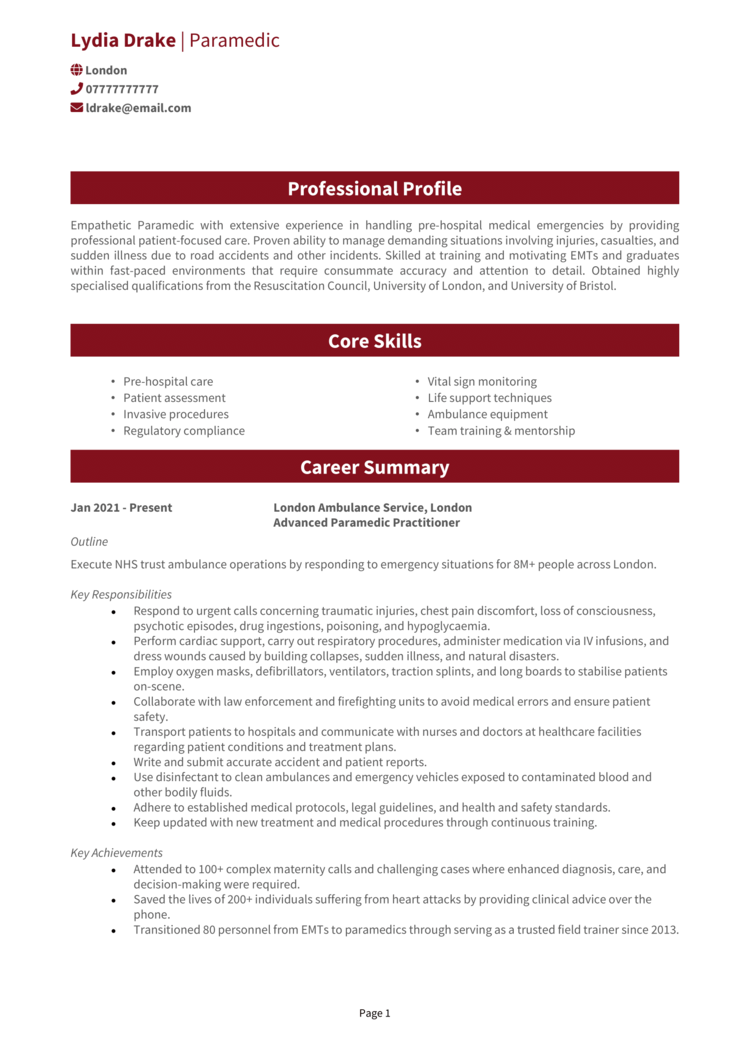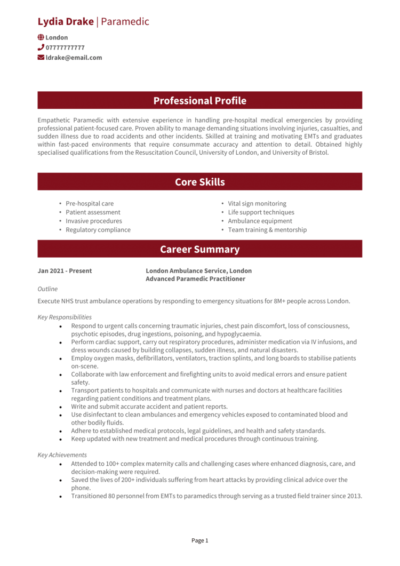As a paramedic, you don’t just respond to emergencies – you help people through their worst moments with empathy and sharp decision-making. But even if you’ve delivered expert care in the field, your next role might come down to how well you communicate that experience on paper.
This guide (with a Paramedic example CV) will help you put together a CV that presents your clinical skills and experience clearly – so you’re ready for the next phase of your career, wherever the call comes from.
Paramedic CV sample

How to write your Paramedic CV
Discover how to craft a winning Paramedic CV that lands interviews with this simple step-by-step guide.
Paramedic work is all about action – but writing a CV requires a moment of reflection. You’ll need to highlight the skills you’ve built across fast-moving situations and the qualifications that prove you’re ready for anything, while demonstrating the judgement you bring to high-pressure decisions.
This guide will help you organise your experience in a way that’s easy to read and relevant to the role, writing a CV which keeps the focus on your practical impact.
The best way to structure and format your Paramedic CV


Whether you’re arriving at a scene, handing over at A&E, or reporting on patient outcomes, clear communication and logical order matter. Recruiters won’t have time to dig through dense blocks of text or vague summaries – your experience needs to be accessible and well presented from the very first line, so a clear layout is essential.
Here’s the structure to follow:
- Name and contact details – Start with your name and contact information – make it simple for recruiters to reach you. Including a photo is a personal choice.
- Profile – Use this section to summarise your experience, strengths, and what makes you a standout candidate.
- Core skills – Outline your primary competencies to give recruiters a snapshot of your strengths.
- Work experience – Walk through your professional experience, beginning with your latest position and moving backwards.
- Education & certifications – Outline your education and certifications, focusing on those most relevant to the role.
- Additional info – Optional extras like languages, awards, or related hobbies.
Use bullet points to keep responsibilities skimmable, choose a clear professional font, and divide each section with bold, distinct headings. Keep your CV length to two pages max. The way you present your information tells the reader a lot about how you communicate under pressure – so a neat format is essential. A CV that’s too dense, vague, or full of mistakes won’t do justice to the precision you bring to your job.
What is a Paramedic CV profile?


Your profile should give a quick overview of who you are and what you bring to a team. Whether you’ve supported frontline emergencies or handled remote medical care, this is the space to summarise your readiness and reliability as a healthcare professional. The overall aim of your CV profile is to convince recruiters that you’re up for the job, and that you’ll bring real value to the role.
Paramedic CV profile examples
Profile 1
Calm and highly trained Paramedic with over five years of frontline experience in emergency medical response for NHS ambulance services. Skilled in trauma care, cardiac support, and pre-hospital diagnosis. Adept at making critical decisions under pressure, supporting patients and families in distressing situations, and working collaboratively with other emergency services.
Profile 2
Dedicated and compassionate Paramedic with four years of experience providing urgent care across urban and rural environments. Proficient in patient assessment, airway management, and administering life-saving treatment in dynamic and high-risk scenarios. Committed to upholding the highest clinical standards while delivering empathetic and efficient care.
Profile 3
Experienced Paramedic with six years of practice in high-pressure environments including road traffic collisions, medical emergencies, and mass-casualty incidents. Confident in using advanced equipment, administering medications, and supporting safe patient transport. Known for professionalism, strong communication skills, and a calm, clear-headed approach to critical incidents.
Details to put in your Paramedic CV profile
Here’s some tips on what to include:
- Where you’ve worked – NHS trusts, ambulance services, private providers, or event medical teams.
- Your top qualifications – Paramedic Science degree, HCPC registration, or first responder certifications.
- Essential skills – Clinical assessment, patient care, emergency protocols, or trauma support.
- Environments or specialisms – Urban response, rural coverage, road traffic collisions, cardiac emergencies.
- Professional strengths – Remaining calm under pressure, leadership in crisis, communication with patients and families.
How to highlight your core skills


This section is your clinical snapshot – think of it as your gear check before heading out. Recruiters will scan this section to quickly assess whether you’ve got the right combination of technical ability and personal strengths for their team.
Rather than padding it with generic soft skills, focus on capabilities that are relevant to the role and setting. You can also include softer but critical traits like crisis communication, cultural sensitivity, or patient reassurance under duress. Make sure each CV skill reflects a real strength – not just a buzzword – and tailor your list to the kind of service or role you’re applying for.
Essential skills for a Paramedic CV
- Emergency Medical Response – Providing immediate care in life-threatening situations, including trauma, cardiac arrest, and respiratory emergencies.
- Patient Assessment and Triage – Quickly evaluating patient conditions, prioritising treatment needs, and determining the most appropriate care.
- Advanced Life Support (ALS) – Performing advanced procedures such as airway management, IV access, ECG interpretation, and drug administration.
- Pre-Hospital Care and Stabilisation – Managing patients at the scene and en route to hospital to ensure stability and prevent deterioration.
- Driving and Navigation Under Emergency Conditions – Operating ambulances safely under blue-light conditions while navigating efficiently.
- Team Coordination and Communication – Working closely with fellow paramedics, emergency responders, and hospital staff to deliver seamless care.
- Patient Transport and Handover – Safely transferring patients to medical facilities and communicating vital information to receiving teams.
- Use of Medical Equipment – Operating defibrillators, ventilators, monitoring devices, and other emergency tools proficiently.
- Documentation and Legal Reporting – Accurately recording patient care, medications administered, and incident details for legal and clinical purposes.
- Public Safety and Education – Offering first aid guidance, supporting community health initiatives, and promoting accident prevention.
How to showcase your work experience in your CV


This is where you show what you’ve done – and how you’ve made a difference. Even if your day-to-day has been fast-paced and unpredictable, your CV needs to translate that into clear, structured examples of your responsibilities and results.
Go through your work experience in reverse chronological order, with the newest stuff first. Make full use of bullet points describing your duties. Focus on your clinical contributions, emergency response, teamwork, and how you ensured patient safety and care across a range of incidents.
How to format previous jobs in your CV correctly

- Outline – Describe the service or environment you worked in, such as a regional ambulance trust or private medical provider.
- Responsibilities – Use action words like “administered,” “assessed,” “stabilised,” or “coordinated.”
- Achievements – Include quantifiable or standout outcomes: “Provided urgent care for up to 10 patients per shift,” “Mentored 3 student paramedics during placements,” “Recognised for calm decision-making during major road collision response.”
Example work history for Paramedics
Paramedic | Westshire NHS Trust
Outline
Delivered emergency medical care across a busy metropolitan area, responding to a wide range of 999 calls as part of a two-person ambulance crew.
Responsibilities
- Assessed patient conditions at scene and delivered appropriate pre-hospital treatment.
- Performed advanced life support, airway management, and trauma care procedures.
- Administered medications and used equipment such as defibrillators and ECG monitors.
- Liaised with A&E departments to ensure smooth handover of patient care.
- Completed incident reports and maintained accurate clinical documentation.
Achievements
- Maintained a high success rate in critical interventions during cardiac arrest calls.
- Received commendation for professionalism during a major road traffic incident.
- Supported a student paramedic mentorship programme across the trust.
Paramedic | Valley Private Ambulances
Outline
Provided urgent and non-urgent medical transportation and on-site care during sporting events, festivals, and private contracts.
Responsibilities
- Delivered medical support at public events, including rapid response to on-site injuries and emergencies.
- Assisted in patient monitoring during inter-hospital and residential transfers.
- Maintained equipment and ensured readiness of medical kits and vehicles.
- Collaborated with private clients and event organisers to provide medical coverage.
- Provided detailed documentation and patient care summaries post-incident.
Achievements
- Responded to over 400 callouts with a high standard of care and efficiency.
- Successfully stabilised multiple high-risk patients prior to hospital transfer.
- Recognised for excellent communication and patient reassurance in high-pressure settings.
Paramedic | Northwood Regional NHS Trust
Outline
Operated as a solo responder in rural and semi-rural areas, delivering life-saving care with limited support and ensuring rapid triage and transfer.
Responsibilities
- Assessed a wide range of medical conditions, often in isolated environments.
- Provided critical treatment using advanced protocols and judgement in the absence of on-site supervision.
- Maintained communication with control rooms and coordinated with other emergency services.
- Advised patients and relatives on aftercare and next steps when hospitalisation wasn’t required.
- Ensured ambulance and equipment were properly cleaned, stocked, and maintained.
Achievements
- Recognised for quick action that contributed to the survival of a cardiac arrest patient.
- Achieved 98% compliance rate on clinical audit assessments.
- Trained two new paramedics in rural emergency protocols and lone working procedures.
Structuring your education section


Your qualifications show you’re legally and clinically ready for the role – so make sure they’re easy to find. Start with your degree or diploma, then list your HCPC registration and any relevant continued training.
You can also include first aid instructor courses or qualifications in mental health or safeguarding. No matter what you include, the education section should be short to make room for your hands-on experience.
Top qualifications to showcase on a Paramedic CV
- BSc (Hons) in Paramedic Science – The standard qualification for paramedic registration.
- HCPC Registration – Essential for working as a registered paramedic in the UK.
- Blue Light Emergency Driving Certificate – Required for operational driving.
- Trauma Management or Advanced Life Support (ALS) Certification – Valuable for handling high-risk cases.
- Mental Health Awareness or Safeguarding Training – Important for working with vulnerable individuals.





